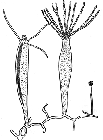Hydrozoa taxon details
Rhysiidae Brinckmann, 1965
- Genus Rhysia Brinckmann, 1965
marine, brackish, fresh, terrestrial
recent only
Brinckmann A. (1965). The biology and development of Rhysia autumnalis gen. nov., sp. nov. (Anthomedusae-Athecatae, Rhysiidae fam. nov.). <em>Canadian Journal of Zoology.</em> 43 : 941-952.
page(s): 942 [details] Available for editors
page(s): 942 [details] Available for editors
Schuchert, P. (2024). World Hydrozoa Database. Rhysiidae Brinckmann, 1965. Accessed at: https://www.marinespecies.org/hydrozoa/aphia.php?p=taxdetails&id=231546 on 2024-04-16
Date
action
by
original description
Brinckmann A. (1965). The biology and development of Rhysia autumnalis gen. nov., sp. nov. (Anthomedusae-Athecatae, Rhysiidae fam. nov.). <em>Canadian Journal of Zoology.</em> 43 : 941-952.
page(s): 942 [details] Available for editors
context source (Hexacorallia) Fautin, Daphne G. (2013). Hexacorallians of the World. (look up in IMIS) [details]
basis of record RAMS Hydrozoa checklist from Dr. Álvaro L. Peña Cantero (look up in IMIS) [details]
page(s): 942 [details] Available for editors
context source (Hexacorallia) Fautin, Daphne G. (2013). Hexacorallians of the World. (look up in IMIS) [details]
basis of record RAMS Hydrozoa checklist from Dr. Álvaro L. Peña Cantero (look up in IMIS) [details]
From editor or global species database
Diagnosis Hydroid stolonal or sessile, polymorphic; hydrorhiza tubular, covered with perisarc; gastrozooid naked, columnar, with either one whorl of filiform tentacles or with nematocyst clusters and a few thick filiform tentacles around hypostome; dactylozooids, when present, covered with perisarc up to capitate tip; gonads on hydranth resembling gastrozooid, on one side of the body, no gonophores; male hydranth with 3 or 4 filiform tentacles, female hydrants with or without tentacles and transforming into a sporosac-like structure with the endoderm forming a spadix, one egg, developing into a planula. [details]
